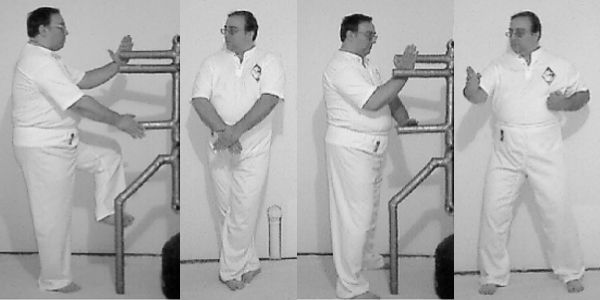Naihanchi or Tekki kata is one of several traditional Chinese-Okinawan karate katas whose origins have been lost over the centuries. While the Naihanchi kata is a relatively short kata with regards to the number of techniques and the amount of repetition contained within, it also possesses a large number of possible combative applications. It is for this reason that many traditional karate stylists are giving their traditional katas a closer look. It is through this closer scrutiny of their individual katas that many karate stylists have made several important discoveries. That many of Karate’s empty-hand katas have direct application(s) not only to grappling, pressure point striking, and weapons, but also for use with a Mook Jong, or Wooden Dummy.
The idea of performing one’s kata against a wooden dummy is not new. In fact, it is commonly used throughout many different styles of Chinese martial arts. The same also applies to other styles of martial arts that use free swinging or fixed heavy bags, as well as makiwara training for arm and leg conditioning. However, what is new is the increased interest in finding the hidden combat applications within a kata: grappling/jujitsu/chin-na, pressure-point strikes, and weapons applications. As interest continues to grow it is feasible that not only mook jong applications but also two-man katas as well could also be invented, or re-invented. The main focus of this text is to illustrate how one of the Naihanchi katas—Naihanchi shodan—can be adapted to a mook jong or wooden dummy.
One of the main features that make Naihanchi a good choice for mook-jong training is due to the limited number of changes in posture and body position. Primarily, there is no 90’ degree, 180’ degree, or 270’ degree turns in its pattern of foot movement (i.e. walking). The Naihanchi exponent generally faces forward, with only minor changes in direction. While the head and arms may turn to focus in a left or right direction, the karate stylist’s body almost always faces forward. This makes it easier to directly apply the different blocks, strikes, and kicks against a stationary target; i.e. a mook-jong.
When using a mook-jong as a training tool one must always try to remember that wooden dummy training attempts to simulate an actual opponent. Traditionally, many of the hand and foot techniques used in Naihanchi are performed with a single technique rhythm: i.e. 1-block, 2-punch, 3-kick, etc. However, when training with the mook-jong, the Naihanchi exponent cannot always follow the traditional flow-pattern/rhythm. Often times, the blocking and striking arms and hands along with the sweeping and kicking legs and feet need to be combined together to get the proper feel of using Naihanchi against a wooden dummy. Therefore, many of the hand and foot techniques need to be combined into an altogether different training pattern/rhythm.
Some traditionalists may believe that the use of the mook-jong may fatally alter their originally perceived ideas concerning Naihanchi kata. However, it does allow the karate stylist a better opportunity in understanding how different striking, kicking, as well as trapping or sticking hand and leg movements can exist within their kata. These same trapping or sticking hand and leg techniques make it easier to apply the many different joint-locks and throws against a real opponent.
Within this text, there is no specific style of Naihanchi Kata (i.e. Shotokan, Shorin-ryu, Shito-Ryu, etc) mentioned. The essential idea of this article is to try and illustrate an otherwise
One of the main features that make Naihanchi a good choice for mook-jong training is due to the limited number of changes in posture and body position. Primarily, there is no 90’ degree, 180’ degree, or 270’ degree turns in its pattern of foot movement (i.e. walking). The Naihanchi exponent generally faces forward, with only minor changes in direction. While the head and arms may turn to focus in a left or right direction, the karate stylist’s body almost always faces forward. This makes it easier to directly apply the different blocks, strikes, and kicks against a stationary target; i.e. a mook-jong.
When using a mook-jong as a training tool one must always try to remember that wooden dummy training attempts to simulate an actual opponent. Traditionally, many of the hand and foot techniques used in Naihanchi are performed with a single technique rhythm: i.e. 1-block, 2-punch, 3-kick, etc. However, when training with the mook-jong, the Naihanchi exponent cannot always follow the traditional flow-pattern/rhythm. Often times, the blocking and striking arms and hands along with the sweeping and kicking legs and feet need to be combined together to get the proper feel of using Naihanchi against a wooden dummy. Therefore, many of the hand and foot techniques need to be combined into an altogether different training pattern/rhythm.
Some traditionalists may believe that the use of the mook-jong may fatally alter their originally perceived ideas concerning Naihanchi kata. However, it does allow the karate stylist a better opportunity in understanding how different striking, kicking, as well as trapping or sticking hand and leg movements can exist within their kata. These same trapping or sticking hand and leg techniques make it easier to apply the many different joint-locks and throws against a real opponent.
Within this text, there is no specific style of Naihanchi Kata (i.e. Shotokan, Shorin-ryu, Shito-Ryu, etc) mentioned. The essential idea of this article is to try and illustrate an otherwise obsure application of Naihanchi. Also, the intention of applying an empty-hand kata to a mook-jong requires the Naihanchi exponent to make slight modifications when applying the individual techniques in sequence against a wooden dummy. While the rhythm of movement may change slightly, the overall level of application(s) should increase.
The mook-jong or wooden dummy being used within the photos is called an Exo-Dummy. This is a variation of the traditional wooden dummy in that it can be used as a accessory to a free standing punching bag.



